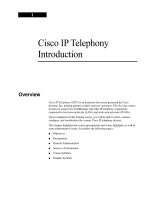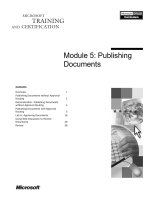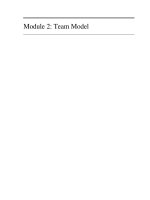Tài liệu ET 200M - IM 153-1/153-2 docx
Bạn đang xem bản rút gọn của tài liệu. Xem và tải ngay bản đầy đủ của tài liệu tại đây (56.61 KB, 4 trang )
ET 200M - IM 153-1/153-2
Overview
z
For connecting ET 200M as slave to PROFIBUS DP (via copper conductors)
z
IM 153-2 can also be used in redundant PROFIBUS DP systems with the S7-400H, software redundancy and the S5-155H
z
With time stamp functionality and time-of-day synchronization
z
Suitable for synchronous operation
Application
The interface module IM 153-1 / IM 153-2 HF is needed for connecting an ET 200M modular I/O station to the PROFIBUS DP fieldbus via copper
conductors.
These headers can therefore be used in the widest possible range of applications.
Fault tolerant systems
In the main, fault tolerant systems are used where no plant stoppage is allowed, such as in energy generation, energy distribution, power stations or
chemical engineering. In conjunction with the fault tolerant
S7-400H (redundant CPUs) the ET 200M can be connected in one-way mode (normal availability) or switched mode (increased availability).
A
dditionally the IM 153-2 can be used not only in applications with software redundancy but also with the S5-155H.
Fail-safe systems
When an error occurs, fail-safe PLCs go into a safe state and protect the safety of people, machines and the environment, for instance in the case of
presses, automated systems or personal transport. Various ET 200M signal modules are available for the purpose of connecting fail-safe signals to the
S7-300F or S7-400F/FH, and provide SIL 2 or SIL 3 depending on the type of connection.
Range exposed to explosion hazard
There are various digital and analog modules for use as intrinsically safe versions for the explosion hazard range, such as in chemical engineering and
pharmaceuticals or on drilling platforms. They support the processing of signals carried on electrically isolated channels from Ex-zone 1. There are also
analog modules with HART capability.
Highly dynamic production processes
Distributed solutions for controlling high speed machines in production and machining processes with high precision are becoming increasingly important,
for instance for automatic speed control. In such cases the time between the capture of a signal by the decentralized I/O equipment and the
corresponding reaction at the actuator must be as short as possible and precisely reproducible. Synchronous connection of a SIMATIC automation
solution to the isochronous PROFIBUS in this way is known as "clock synchronization" and is supported by various ET 200M signal modules.
ET 200M - IM 153-1/153-2CA 01
Seite 1 von 4
Design
z
The IM 153-1/153-2 interface module is used as a header module of the ET 200M. Up to 8 I/O modules from the S7-300 programmable controller's
module range can be connected to the interface.
z
The interface module and the required I/O modules are mounted on a DIN rail for S7-300. For this purpose, bus connectors are used to connect the
I/O modules to each other and to the IM 153 interface module.
z
For redundant mode two IM 153-2s are mounted on the BM IM/IM bus module.
z
Various types of I/O modules can be plugged in depending on the quantity framework of the master module.
z
Can be operated without fans.
z
Max. 8 S7-300 standard I/O modules can be driven per IM 153-2 FO No slot rules apply.
Function
Features of the IM 153 IM 153-1AA03 (Basic)
6ES7 153-1AA03-0XB0
IM 153-2 (High Feature)
6ES7 153-2BA00-0XB0
RS 485 interface Yes (copper) Yes (copper)
Fiber-optic interface No No
Implementing the DP V1
standard
Yes Yes
Module replacement
during operation
Yes Yes
FREEZE capability Yes Yes
SYNC capability Yes Yes
Pass on parameter
assignment data from
PG/PC (with S7
functionality; on S7
masters only)
No Yes
Use of function modules
(FM) and communication
processors (CP)
Restricted Yes
Time synchronization on
PROFIBUS, time
stamping of input signals
1)
No Yes
Redundancy (software
redundancy, S7-400H,
S5-155H)
No Yes
Change of configuration
in the RUN 2)
z
In a redundant system No Yes
z
In a non-redundant
system
No Yes
Identification data 3) No Yes
Support for isochrone
mode 4)
No Yes
Firmware update via bus /
micro memory card
No Yes
Direct data exchange Yes Yes
ET 200M - IM 153-1/153-2CA 01
Seite 2 von 4
1) Changes to digital inputs are in fact provided with a time stamp locally (in the IM 153 on the ET 200M) and transmitted to the CPU by means of a
process interrupt.
2) Change of configuration in the RUN means that changes to the hardware configuration, such as reparameterizing or adding modules, can be carried
out during operation with no adverse reaction.
3) Identification data refers to information such as an order number, version, installation date, plant identifier etc. stored in a module so as to identify that
module uniquely and to be available online, typically to be used for purposes such as fault correction.
4) Isochrone mode means the synchronous connection of a distributed I/O and user program to the equidistant PROFIBUS. Thus the actual value
acquisition and set point output take place synchronously and at uniform intervals with simultaneously consistent data images.
Operating mode
The IM 153 interface module completely takes over communication between the modular ET 200M I/O station and the higher level master connected to
the PROFIBUS DP.
The inputs and outputs are assigned to the respective master during configuring.
The IM 153-2 interface module enables assembly of redundant PROFIBUS DP systems. If the active branch fails, the passive IM 153-2 assumes
bumpless control of the relevant functions.
Signals can be monitored for change with a time stamp. Modules approved for time stamping must be used for this purpose (e.g. SM 321-7BH, etc.).
Parameter assignment
z
STEP 7;
Configuration is carried out using HW Configuration, by selecting the appropriate headend from the corresponding hardware catalog. Configuration
using modules is then likewise carried out from the appropriate HW catalog.
z
COM PROFIBUS;
From Version 5.0 onwards, configuration is carried out by entering the order number.
z
Third party tools;
Interfacing to external masters and configuration using external tools are carried out using the GSD (device master data) file.
Technical specifications
Extended diagnostics Yes Yes
Extended ambient
conditions (outdoor)
Yes, with 6ES7 153-
1AA83-0XB0
No
Certification for Ex-zone 2 Yes Yes
6ES7 153-1AA03-0XB0 6ES7 153-2BA00-0XB0
Power supply
z Line supply/voltage failure buffering
5 ms
Input voltage
Rated value, 24 V DC Yes
permissible range, lower limit (DC) 20.4 V; including ripple
permissible range, upper limit (DC) 28.8 V; including ripple
Input current
Rated value at 24 V DC 625 mA
Output voltage
Rated value (DC)
5 V
Rated value, 5 V DC Yes
Output current
for backplane bus (5 V DC), max. 1 A
1 A
Supply voltages
Rated value
24 V DC
Yes
permissible range (including ripple) lower limit (DC)
20.4 V
permissible range (including ripple) upper limit (DC)
28.8 V
Current consumption
z Inrush current, typ.
2.5 A
2.5 A
z I²t
0.1 A²s
0.1 A²s
z
Current consumption, max.
350 mA
550 mA
z Power dissipation, typical
3 W
5 W
Address area
Addressing range
Outputs 128 Byte
128 Byte
ET 200M - IM 153-1/153-2CA 01
Seite 3 von 4
Inputs 128 Byte
128 Byte
Configuration
z
Number of modules per DP slave interface module, max.
8
Communication functions
z
Bus protocol/transfer protocol
PROFIBUS DP to EN 50 170
PROFIBUS-DP to EN 50 170
Interfaces
z PROFIBUS DP, output current, max.
90 mA
z
Physical interface, RS485
Yes
Yes
Connection system
z
PROFIBUS DP
9-pin sub-D female connector
RS 485
PROFIBUS DP
z Transmission rate, max.
12 Mbit/s
12 Mbit/s
z Automatic transmission speed detection
Yes
Yes
z SYNC capability
Yes
Yes
z
FREEZE capability
Yes
Yes
z Direct data exchange (lateral communication)
Yes; Sender
Yes; Sender
1st interface
DP slave
Automatic baud rates search Yes
Yes
CPU/ programming
Configuration software
STEP 7
Yes; STEP 7 / COM PROFIBUS / non-Siemens tools via GSD
file
Timestamp
z
Accuracy
10 ms
z Number of event buffers
15
z Messages per event buffer
20
z Number of stamped digital inputs, max.
128
z Time resolution
1 ms
z
Time interval for transm. the message buffer if there is a
mess.
1,000 ms
Insulation
z Insulation tested with
Insulation voltage 500 V
Insulation voltage 500 V
Environmental requirements
Operating temperature
min. 0 °C
0 °C
max. 60 °C
60 °C
Air pressure
Altitude above MSL, max.
3,000 m
Degree of protection and class of protection
IP 20 Yes
Yes
Dimensions and weight
z Weight, approx.
360 g
360 g
z Width
40 mm
40 mm
z Height
125 mm
125 mm
z
Depth
117 mm
117 mm
ET 200M - IM 153-1/153-2CA 01
Seite 4 von 4









